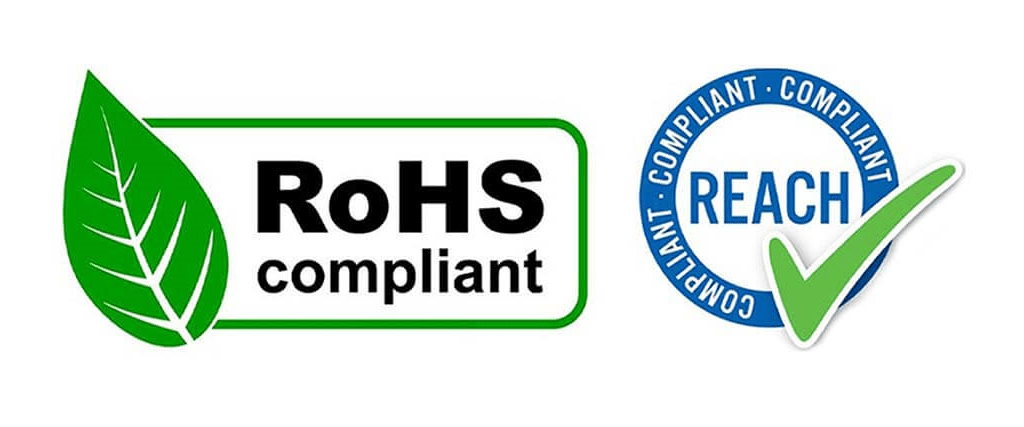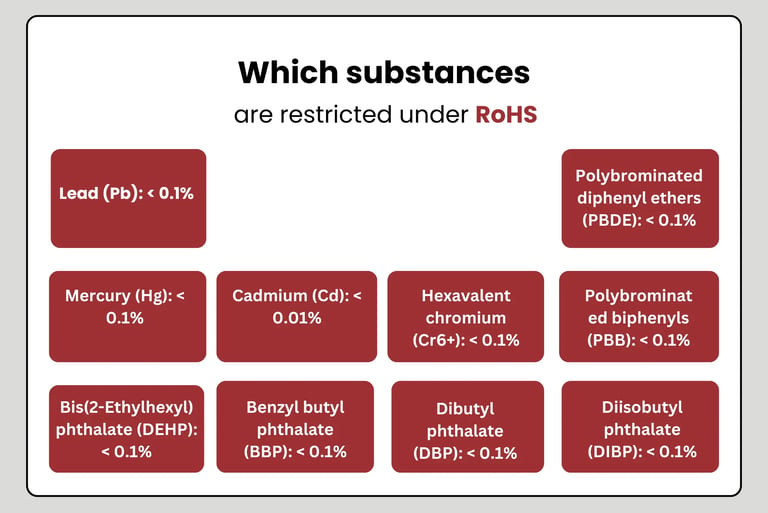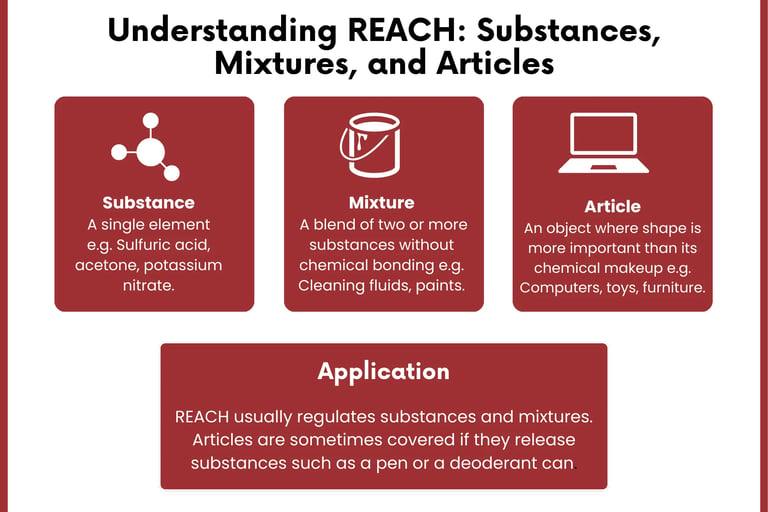RoHS and REACH Compliance: What Electronics Manufacturers Need to Know
RoHS and REACH, originating in the European Union (EU), have a significant impact on how electronic products are designed, manufactured, and marketed. Companies that overlook these regulations risk facing legal consequences, financial penalties, and loss of market access.
2/18/20257 min read


For electronics manufacturers, understanding and complying with RoHS (Restriction of Hazardous Substances) and REACH (Registration, Evaluation, Authorization, and Restriction of Chemicals) regulations is no longer just a good practice—it’s a necessity. These two laws, originating in the European Union (EU), have a significant impact on how electronic products are designed, manufactured, and marketed. Companies that overlook these regulations risk facing legal consequences, financial penalties, and loss of market access. But with the right approach, compliance can be a competitive advantage and demonstrate a commitment to sustainability. In this article, we will explore the details of RoHS and REACH, why compliance matters, and provide real-world examples and practical guidance on how electronics manufacturers can meet these important standards.
What is RoHS (Restriction of Hazardous Substances)?
RoHS, which was first introduced by the European Union in 2003, aims to limit the use of specific hazardous substances in electrical and electronic products. Initially, the law was designed to curb the environmental and health risks posed by electronic waste (e-waste), but its impact has grown far beyond that. Over the years, RoHS has been updated to include additional substances and products, and its scope now covers a wide range of electrical and electronic devices.
Key Substances Restricted by RoHS
RoHS restricts the use of six substances that are commonly found in electronic devices:
Lead (Pb)
Mercury (Hg)
Cadmium (Cd)
Hexavalent chromium (Cr(VI))
Polybrominated biphenyls (PBB)
Polybrominated diphenyl ethers (PBDE)
These substances are known to be toxic and can pose severe environmental and health risks, particularly during the disposal and recycling of e-waste. For example, lead has been linked to neurological damage, mercury can contaminate water sources, and cadmium is a carcinogen.
Real-World Case: A notable example of RoHS compliance failure is the case of Philips in 2013. The company faced significant regulatory scrutiny when one of its lightbulb products, manufactured in compliance with RoHS standards, was found to contain excessive levels of mercury, a banned substance under RoHS. The product was pulled from the market, and Philips was forced to implement a costly recall. This incident underscores the importance of stringent testing and documentation to avoid similar costly mistakes.
RoHS Compliance in Practice:
RoHS compliance means that electronics manufacturers must ensure that their products do not exceed the allowable concentrations of these substances. Companies must also work with suppliers to ensure that the components they source are also RoHS-compliant. Regular testing and certification are necessary to validate compliance. If a company is found selling non-compliant products, the repercussions can be severe, including fines, sales bans, and even product recalls.


What is REACH (Registration, Evaluation, Authorization, and Restriction of Chemicals)?
REACH is a regulation that came into force in the European Union in 2007. It focuses on the safe use of chemicals across all industries, not just electronics, and aims to improve the protection of human health and the environment. Unlike RoHS, which is concerned with a small number of substances used in electrical and electronic products, REACH covers a vast range of chemicals used in manufacturing across various sectors.
Key Aspects of REACH:
REACH places responsibility on manufacturers and importers to assess and manage the risks posed by chemicals used in their products. The regulation requires that any chemical substances produced or imported into the EU in quantities of 1 ton or more per year be registered with the European Chemicals Agency (ECHA). Furthermore, substances that are deemed particularly hazardous must undergo an evaluation and authorization process.
REACH also has a “substances of very high concern” (SVHC) list, which includes chemicals that are carcinogenic, mutagenic, or toxic to reproduction. If a substance is added to this list, manufacturers must notify authorities and may face restrictions on its use in their products.
Real-World Case: A classic example of the importance of REACH compliance comes from Apple Inc. In 2011, Apple had to recall some of its MacBook and iPhone products due to the presence of a substance classified as a SVHC. This was an expensive mistake, not only because of the recall costs but also because it damaged the company’s reputation for being an environmentally responsible brand. Apple’s case highlights how REACH compliance isn’t just about avoiding penalties—it's also about maintaining customer trust and brand integrity.
The REACH Compliance Process:
Achieving REACH compliance involves several steps:
Chemical Registration: Manufacturers must register chemicals used in their products with ECHA. This process includes providing detailed information on the chemical’s properties, potential hazards, and safety measures.
Substance Evaluation: If a substance is identified as dangerous, it may undergo a more rigorous evaluation by the authorities, which can lead to restrictions or a ban on its use.
Authorization for Use: For particularly harmful substances, manufacturers may need to apply for special authorization to use them, which is granted on a case-by-case basis.


RoHS vs. REACH: Key Differences and Overlap
While both RoHS and REACH aim to safeguard human health and the environment, they differ in several key aspects.
Scope:
RoHS: Primarily focuses on electrical and electronic equipment.
REACH: Covers a broad range of chemicals used across multiple industries, including chemicals in electronics, automotive, and even textiles.
Substances:
RoHS: Targets a specific list of six substances that are found in electrical and electronic products.
REACH: Covers thousands of chemicals and includes a more detailed system for assessing risk, banning, or restricting chemicals.
Compliance Process:
RoHS: Compliance is typically verified through testing of the final product.
REACH: Requires detailed chemical registration, evaluation, and ongoing monitoring of chemicals used.
Market Impact:
RoHS: Applies to products sold within the EU market, particularly electronics.
REACH: Also applies to products sold in the EU, but manufacturers worldwide need to be aware of REACH compliance if their products contain regulated chemicals.
Why Compliance Matters for Electronics Manufacturers
Failing to comply with RoHS and REACH can have significant consequences. Consider the following reasons why compliance is crucial for electronics manufacturers:
1. Legal and Financial Risks
Non-compliance can lead to fines, legal disputes, and forced recalls, all of which can severely impact your bottom line. For instance, Sony was fined in 2017 after it was found that several of its products contained restricted substances beyond the allowed thresholds. This not only resulted in costly fines but also damaged the brand’s reputation.
2. Market Access
RoHS and REACH compliance is a prerequisite for selling products in the EU market. But it doesn’t stop there—many other countries and regions, including China, Japan, and the United States, have adopted similar regulations. Failing to comply with these regulations could block access to these lucrative markets.
3. Environmental Responsibility and Brand Image
Consumers are increasingly aware of environmental and health issues. By ensuring your products comply with RoHS and REACH, you send a strong message that your company is committed to sustainability and responsible manufacturing practices. For instance, Samsung and Dell have worked hard to ensure their products meet RoHS and REACH standards, aligning themselves with the growing consumer demand for sustainable products.
4. Competitive Advantage
Compliance can also give you a competitive edge in the market. Companies that are proactive about sustainability are often viewed more favorably by investors, partners, and customers. By staying ahead of the curve on regulatory compliance, you position your business as an industry leader.
Steps for Achieving RoHS and REACH Compliance
Achieving compliance with RoHS and REACH may seem daunting, but it’s a manageable process if broken down into clear steps. Here’s a practical guide for manufacturers:
1. Conduct a Chemical Inventory
Start by reviewing all the chemicals used in your products, including those in raw materials and components. Collaborate with suppliers to obtain detailed information on the substances they use and their compliance status.
2. Implement Supplier Communication Protocols
Establish clear communication channels with your suppliers to ensure that you receive up-to-date documentation and certificates of compliance. Regularly audit your supply chain to ensure that they meet your compliance requirements.
3. Testing and Certification
In some cases, you may need to test your products for RoHS or REACH compliance. Third-party laboratories can help with testing to ensure that your products meet the required standards. Certification bodies can provide official documentation that proves your products meet regulatory standards.
4. Regular Monitoring and Updates
Regulations change, so it’s crucial to stay informed about any updates to RoHS and REACH. Implement a system to monitor regulatory changes and ensure that your products remain in compliance over time.
5. Documentation and Record-Keeping
Maintain detailed records of your compliance efforts, including testing results, supplier declarations, and certification documents. This will help you respond quickly to audits or regulatory inquiries.
Challenges Electronics Manufacturers Face in Achieving Compliance
The road to compliance isn’t without its challenges. Some common hurdles include:
Complexity of Regulations: The rules surrounding RoHS and REACH can be difficult to navigate, especially as the regulations evolve.
Cost: Compliance comes with its costs, including testing, certification, and potential modifications to products or production processes.
Global Supply Chains: Managing compliance across a global supply chain, especially when working with multiple suppliers, can be complex and time-consuming.
Tools and Resources to Help with Compliance
Thankfully, several tools and resources can assist manufacturers in navigating the compliance process:
Compliance Management Software: Tools like ComplianceMap and RoHS Express help track and manage compliance across products and suppliers.
Certification Bodies: Organizations such as SGS and TÜV Rheinland offer testing and certification services for both RoHS and REACH compliance.
Government Resources: The EU provides detailed guidance on RoHS and REACH through official websites, which include up-to-date lists of restricted substances and compliance guidelines.
The Future of RoHS and REACH Compliance
As environmental concerns continue to grow, regulations around hazardous substances will likely become even stricter. Manufacturers must keep an eye on these changes and adapt their practices accordingly. There’s also a growing trend toward enhancing the recyclability of electronic products, and future RoHS updates may focus more on this aspect.
Conclusion
RoHS and REACH compliance are not just about avoiding fines—they are key to staying competitive in a market that increasingly values environmental responsibility and sustainability. By understanding these regulations, implementing the necessary compliance steps, and using the right tools and resources, electronics manufacturers can safeguard their business and position themselves as leaders in the industry. Through proactive compliance, you can not only avoid costly mistakes but also build a reputation for sustainability, improve market access, and gain a significant edge in today’s environmentally-conscious global market.
